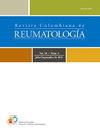Factores asociados con el diagnóstico de síndrome antifosfolípido: ¿cuándo debemos solicitar los estudios?
Q3 Health Professions
引用次数: 0
Abstract
Introduction
In clinical practice, there is no established guidance on the timing of sample collection when suspicion of antiphospholipid syndrome (APS) arises. Instead, only a list of risk factors for APS exists, without adequate quantification of the significance of each factor.
Materials and methods
Analytical observational case-control study, nested in a retrospective cohort of patients with venous or arterial thrombosis in whom APS was suspected. Patients with a confirmed diagnosis of APS according to the Sapporo criteria or triple positive initial result (cases) were compared with patients negative for APS (controls). The aim was to assess the association between the diagnosis of APS and various clinical and paraclinical factors.
Results
68 patients were included (72% women, 41.2% with deep venous thromboembolism and 29.4% with pulmonary embolism). In 18 patients APS was confirmed. There were no significant differences in age in patients with and without confirmation of the diagnosis (44.0 ± 17.9 vs. 51.2 ± 14.9, P = .069). In the multivariate analysis, a significant and independent association was found between having APS and rheumatic disease (OR: 12.1, P = .02), PTT prolongation (OR: 17.6, P = .014), platelet count < 150,000 (OR: 18.6, P = .008), and a history of previous thrombosis events (OR: 6.1 for each event, P = .027).
Conclusions
In patients with arterial or venous thrombosis, there is a greater possibility of confirming APS if there is a history of rheumatic disease, prolongation of PTT to more than 5 seconds, thrombocytopenia, and previous events of thrombotic disease. In these patients, it is advisable to screen for APS, to prevent the further occurrence of thrombotic events.
诊断抗磷脂综合征的相关因素:何时应进行检测?
在临床实践中,当怀疑出现抗磷脂综合征(APS)时,没有既定的样本采集时间指导。相反,只有APS的危险因素列表存在,没有充分量化每个因素的重要性。材料和方法分析观察性病例对照研究,纳入了一组疑似APS的静脉或动脉血栓患者的回顾性队列。根据Sapporo标准确诊APS的患者或初始结果三阳性的患者(病例)与APS阴性的患者(对照组)进行比较。目的是评估APS的诊断与各种临床和临床旁因素之间的关系。结果共纳入68例患者(72%为女性,41.2%为深静脉血栓栓塞,29.4%为肺栓塞)。18例患者确诊APS。确诊与未确诊患者的年龄差异无统计学意义(44.0±17.9∶51.2±14.9,P = 0.069)。在多因素分析中,APS与风湿病(OR: 12.1, P = 0.02)、PTT延长(OR: 17.6, P = 0.014)、血小板计数和lt之间存在显著且独立的关联;15万(OR: 18.6, P = 0.008),以及既往血栓事件(OR: 6.1, P = 0.027)。结论在动脉或静脉血栓形成的患者中,有风湿病史、PTT延长5秒以上、血小板减少、血栓性疾病既往事件的患者,APS的确诊可能性较大。在这些患者中,建议筛查APS,以防止血栓事件的进一步发生。
本文章由计算机程序翻译,如有差异,请以英文原文为准。
求助全文
约1分钟内获得全文
求助全文
来源期刊

Revista Colombiana de Reumatologia
Medicine-Rheumatology
CiteScore
0.80
自引率
0.00%
发文量
92
期刊介绍:
The Colombian Journal of Rheumatology (Revista Colombiana de Reumatología) is the official organ of the Colombian Association of Rheumatology (Asociación Colombiana de Reumatología) and the Central American, Caribbean and Andean Association of Rheumatology (Asociación Centroamericana Caribe Andina de Reumatología) - ACCA. It was created in December 1993 with the purpose of disseminating scientific information derived from primary and secondary research and presenting cases coming from the practice of Rheumatology in Latin America. Since its foundation, the Journal has been characterized by its plurality with subjects of all rheumatic and osteomuscular pathologies, in the form of original articles, historical articles, economic evaluations, and articles of reflection and education in Medicine. It covers an extensive area of topics ranging from the broad spectrum of the clinical aspects of rheumatology and related areas in autoimmunity (both in pediatric and adult pathologies), to aspects of basic sciences. It is an academic tool for the different members of the academic and scientific community at their different levels of training, from undergraduate to post-doctoral degrees, managing to integrate all actors inter and trans disciplinarily. It is intended for rheumatologists, general internists, specialists in related areas, and general practitioners in the country and abroad. It has become an important space in the work of all rheumatologists from Central and South America.
 求助内容:
求助内容: 应助结果提醒方式:
应助结果提醒方式:


